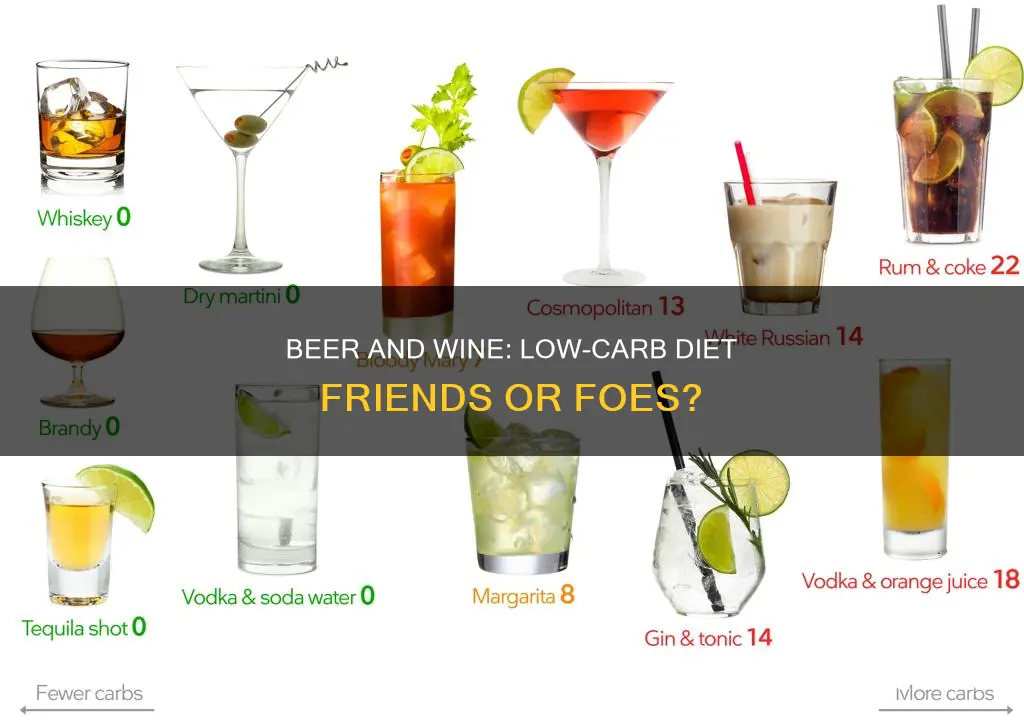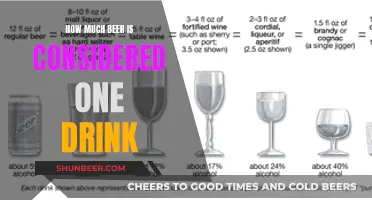
If you're on a low-carb diet, you may be wondering if you can still enjoy a drink. The short answer is yes, but it depends on what you're drinking. Beer and wine can be relatively high in carbohydrates, with beer containing 3–12 grams of carbs per 12-ounce (355-ml) serving, and wine typically containing 3–5 grams of carbs per serving. However, certain types of beer and wine are better options for those watching their carb intake. For example, light beer and dry wines, such as Cabernet Sauvignon, Merlot, and Pinot Noir, are lower in carbs. In addition, pure forms of liquor like rum, whiskey, gin, and vodka are completely carb-free. So, if you're on a low-carb diet, it's best to choose your drinks wisely and always consume alcohol in moderation.
| Characteristics | Values |
|---|---|
| Carbohydrates | Beer contains more carbs than wine, with 13 grams of carbs in a typical serving of beer and 3-5 grams in a typical serving of wine. |
| Calories | Alcoholic drinks contain "empty calories", with most drinks containing at least 100 calories and some cocktails containing over 500 calories per serving. |
| Weight Loss | Alcohol may slow down weight loss as it is an energy source that the body burns before burning other sources of energy, such as body fat. |
| Appetite | Alcohol can stimulate appetite and decrease inhibitions, leading to increased food intake. |
| Nutrition Labels | Alcohol does not have nutrition labels, making it harder to figure out how it fits into a diet. |
| Low-Carb Options | Wine and light beer are relatively low in carbs, with 3-4 grams per serving. Pure forms of liquor like rum, whiskey, gin, and vodka are carb-free. |
| High-Carb Options | Cocktails and mixed drinks are high in carbs due to sugary ingredients like soda, juice, sweeteners, or syrups. Regular beer is also high in carbs, with over 12 grams of carbs in a can. |
What You'll Learn

Beer is packed with carbs
Beer is a drink that is packed with carbohydrates. Starch is one of its primary ingredients, and beer typically contains 3–12 grams of carbs per 12-ounce (355-ml) serving. This amount varies depending on whether it is a light or regular variety. For example, a stout such as Guinness has 18g of carbohydrates per pint, while Budweiser Select 55 has only 1.9g of carbs per serving.
Beer is one of the highest-carb alcoholic beverages, along with mixed drinks that contain sugar, juice, and other high-carb mixers. These drinks can contain over 30 grams of carbs per serving.
Because of its high carb content, beer is not a good choice for people trying to lose weight or improve diabetes control. It is also not a good option for those following a keto or low-carb diet, as it can quickly throw off their macros with just a single drink.
The hops and fermented grains in beer are like drinking liquid bread, which is why it is often associated with abdominal obesity and "beer bellies." The high carb content of beer can also cause a rapid increase in blood glucose and insulin levels.
When trying to cut down on carbs, it is best to choose lower-carb alcoholic beverages such as wine, champagne, or pure spirits like whiskey, gin, or vodka. These drinks have a much lower carb content and are better options for weight control.
Drinking Beer While Boating: Is It Legal?
You may want to see also

Wine is a much better option than beer
If you're on a low-carb diet, you may be wondering if you can still enjoy a drink. The short answer is yes, but it's important to choose your tipple wisely. When it comes to wine vs beer, wine is generally a much better option if you're watching your carb intake.
The Carb Content of Wine and Beer
Wine and beer differ significantly in their carb content. Beer is typically high in carbs, with a standard 12-ounce (355ml) serving containing 3-12 grams of carbs. The exact amount depends on various factors, such as whether it's a light or regular variety.
On the other hand, wine is relatively low in carbs. A typical 5-ounce (150ml) serving of wine contains around 3-4 grams of carbs, with dry wines containing even fewer carbs. For example, a glass of champagne or dry white or red wine has around 2 grams of carbs per serving.
The Impact on Weight Loss
Alcoholic drinks are known for their "empty calories", providing a lot of calories with little to no essential nutrients. This can contribute to nutritional deficiencies and weight gain over time. Additionally, alcohol can slow down fat burning by causing your body to prioritise burning alcohol over burning fat.
When it comes to weight loss, wine is a better choice than beer. Beer is often referred to as "liquid bread" due to its high carb content, which can hinder weight loss. On the other hand, dry wines, which have no residual sugar, are lower in carbs and are less likely to impact blood sugar or insulin levels.
Other Considerations
It's worth noting that the impact of alcohol on weight loss goes beyond its carb content. Alcoholic drinks can stimulate appetite and decrease inhibitions, leading to increased food intake. Additionally, when following a low-carb diet, your tolerance for alcohol may decrease, so it's important to drink in moderation and be mindful of your consumption.
In summary, while it's important to consume alcohol in moderation, wine is generally a much better option than beer if you're following a low-carb diet.
Footballers and Beer: Is It a Good Mix?
You may want to see also

Pure spirits are carb-free
Pure spirits such as whiskey, gin, tequila, rum, cognac, and vodka contain no carbs and are suitable for a keto diet. However, the mixers that are often added to these drinks can be high in carbs. For example, tonic water, juice, and soda all contain carbohydrates. Therefore, if you want to stick to your low-carb diet, it is best to drink spirits straight or mix them with low-carb options like diet soda, soda water, or sugar-free tonic water.
If you are drinking spirits with mixers, be mindful of your consumption, as it is easy to overindulge and exceed your daily carb limit. Additionally, when on a low-carb diet, your tolerance for alcohol decreases, so ensure you drink a glass of water after each alcoholic beverage and be cautious about reaching for a second drink.
While pure spirits are carb-free, they are still calorie-dense and can contribute to weight gain and nutritional deficiencies if consumed in excess. Alcohol is prioritised by the body for metabolism over other nutrients, which can slow down fat burning and increase weight gain. Therefore, it is important to drink in moderation, which is defined as one drink per day for women and two drinks per day for men.
Drinking Beer Post-Massage: What You Should Know
You may want to see also

Alcoholic drinks contain empty calories
Alcoholic drinks are often referred to as "empty calories" because they provide a high number of calories with little to no essential nutrients such as protein, fibre, vitamins, or minerals. Alcohol is the second most calorie-dense nutrient after fat, with around seven calories per gram, almost as many as pure fat. A standard glass of wine can contain up to 158 calories, and some stronger lagers can have up to 222 calories.
The calories in an alcoholic drink are not just from the alcohol itself but also from other ingredients such as sugar and mixers. Many alcoholic drinks are higher in calories than people realise, and these extra calories can contribute to weight gain over time. Alcohol can also negatively affect blood sugar levels, as the liver prioritises getting rid of the alcohol over its normal functions like glucose production, which can lead to low blood sugar levels (hypoglycaemia).
In addition to the high-calorie content, alcoholic drinks can also contain a lot of sugar. For example, a bottle of white wine (12.5%, 750ml) contains 564 calories and 22.5 grams or 4.5 teaspoons of sugar. Liqueurs and sweet wines tend to have the most sugar due to added sugars to enhance their sweetness.
When consumed in excess, alcohol can also slow down fat burning and increase fat storage. Studies have shown that heavy drinking can block fat burning and contribute to weight gain. Alcohol is prioritised over other nutrients for metabolism, which can cause extra carbs, protein, and fat to be stored as fat tissue.
Therefore, while it is possible to consume some alcoholic drinks on a low-carb diet, it is important to do so in moderation. The NHS recommends that men and women should not regularly drink more than 14 units of alcohol per week, spread across three or more days, to maintain a healthy weight and avoid adverse health effects.
Healthy Beer Choices: Calorie-Conscious Drinking
You may want to see also

Alcohol can slow down fat burning
Alcohol can indeed slow down fat burning and hinder weight loss. When you drink alcohol, your body metabolises it first, before other nutrients, to use it as fuel. This is because the body considers alcohol a toxin or waste product, and it will shut down all other metabolic pathways until the alcohol is out of your system. It can take the body up to 36 hours to work through the alcohol, during which time it will not be burning fat.
Alcohol is calorie-dense, making it a more attractive energy source for the body. It is the second most calorie-dense nutrient after fat, packing seven calories per gram. Adding even a single serving of alcohol to your diet every day can add hundreds of extra calories while contributing next to no protein, fibre or micronutrients. This can contribute to nutritional deficiencies and may also lead to weight gain over time.
Heavy alcohol consumption can also decrease fat breakdown and increase fatty acid synthesis, leading to the accumulation of triglycerides in the liver, causing a condition called fatty liver disease. Alcohol can also cause the liver to create more cholesterol and fat.
It is important to note that excessive drinking may also contribute to other serious health conditions, including liver problems, cancer, and heart disease. Therefore, it is recommended to keep alcohol intake moderate, which is defined as one drink per day for women and two per day for men.
Beer, Anxiety, and You: A Curious Concoction
You may want to see also
Frequently asked questions
Beer typically has a high carb content due to starch being one of its primary ingredients. A 12-ounce can of beer usually contains more than 12 grams of carbs. Light beers, however, are relatively low in carbs, usually containing under 6 grams per serving.
Yes, wine is reasonably low-carb compared to other alcoholic drinks. A standard wine serving of 5 ounces contains around 3-4 grams of carbs for dry red or dry white wine. Dessert wines and fortified wines can have significantly higher levels of carbohydrates, up to 20 grams per serving.
Pure forms of alcohol like whiskey, gin, tequila, rum, and vodka are completely free of carbs. These can be consumed straight or mixed with low-carb options like diet soda or sugar-free tonic water. Dry Champagne, Prosecco, and Cava are also good choices, with minimal carbs that can be enjoyed in moderation.
Terms to avoid on wine labels include Süss/Doux, Eiswein or Ice Wine, Late Harvest, Dessert Wine, Dolce, Spatlese, Auslese, Demi-sec, Semi-sec, and Fortified Wine. Look for terms like Dry, Sec, Trocken, Brut, and Brut Nature to indicate lower-carb options.







